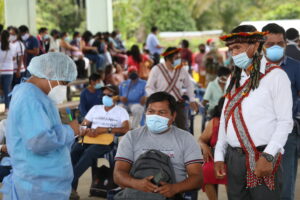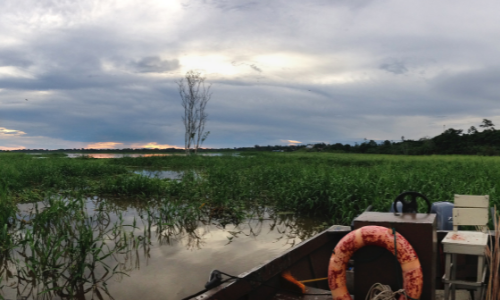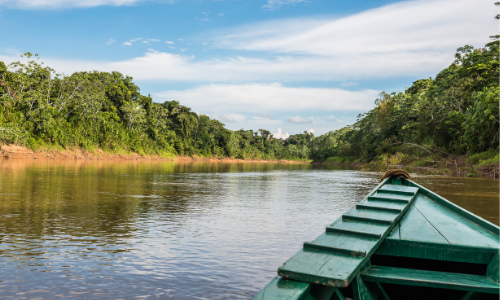Peru has the highest number of COVID-19 deaths per 100,000 inhabitants and is in last place in Latin America in terms of vaccinations given. However, as the government has just secured more vaccines, there is another virus that is especially affecting Indigenous people in remote regions of the country: disinformation and scary conspiracy theories about the vaccines.
LatAm Journalism Review (LJR) spoke with six journalists from community radio stations in the Peruvian Amazon that have been working to combat disinformation surrounding the COVID-19 vaccines.

Residents of Amazon communities are vaccinated against COVID-19 by the Peruvian Ministry of Health (MINISTERIO DE SALUD PERU/MINSA)
From Loreto, the largest region in the Amazon with 28 ethnic groups
Talking with the Quechua, Bora, Ticuna, Maicuna and other ethnic groups of the Amazon in more than 40 Indigenous communities of the Loreto and Pucallpa regions. This was the first task for Katya Zevallos Ynmenso, journalist and communicator of the Regional Organization for Indigenous Peoples of the East (ORPIO, for its acronym in Spanish), when it came to understanding fears, prejudices and questions surrounding the vaccine and proposing the creation of a communications plan for Indigenous communities.
"The Indigenous brothers know that they are going to be vaccinated, but since no information arrives, they are afraid, prejudiced,” the journalist told LJR. “In the local evangelical churches they have been told that COVID-19 is the work of the devil, that they are going to introduce a chip to control them or kill them, also that their traditional medicine is enough to confront the pandemic. There is an overabundance of false information that is not substantiated. In the communities, there is no fluid internet to use cell phones or tablets, the only media that communicates strongly is the radio. The Indigenous brothers travel to places to look for a signal.”
The work has involved going from community to community, returning to basic communication with the objective that all residents have the same access to official information so that they decide to be vaccinated without the intention of imposing anything on them.
They have brought infographics with information in the native language, with great empathy, to create links. Even deciding the space where this infographic is posted is an agreement with the school, in the community.
Picking up the loudspeaker, using the community radio to broadcast purposeful information and with direct messages is part of the actions of the communicators themselves from the same communities, because they also know that the dynamics of the community begins at 4 or 5 in the morning. Also, they have been creating graphic information, with comics, drawings, for the residents who do not have such ease of reading, with drawings that make the process understandable.
In the province of Nauta, in the Loreto region, in northern Peru, journalist Henry Vela told LJR that since the beginning of the pandemic, Inspiración Nauta radio has dedicated a good part of its programming to receiving calls from the communities, redirecting requests to State institutions to clarify doubts about vaccines, broadcasting verified information on COVID-19 or calls from the Achuar, Kukama, Kiwcha and other communities.
From the program he directs, "Inspiración en la Noticia," which airs from Monday to Friday from 6 a.m. to 9 a.m., Vela has linked residents with health authorities in live broadcasts, where they have answered various questions.
For Vela, making sure health agents are available to take questions has been a priority, not only through receiving calls, but also reporters go to the communities to collect concerns and transmit questions, if possible with live broadcast.

The issues are diverse: The absence of health personnel, health posts flooded with water due to rising rivers, lack of or delayed medicine, older adults who have not been vaccinated, total absence of masks or preventative kits that were reported to have been distributed. All information is verified with testimony from the Apus or authorities.
The geography is very extensive in this border area, the communities can be a week away by river, which hinders cell phone signals, use of the internet and often the arrival of radio or TV signals.
A community asked a reporter to go, but the trip took three days and the radio station did not have a budget. The community, with the support of a local entrepreneur, raised money to cover the transportation costs. Therefore, it has been possible to report on doubts around the vaccines.
For Vela, it has been a challenge and personal commitment to produce content or radio spots. He has had to count on the volunteer support of native language translators to produce information that raises awareness about the vaccines.
“You cannot translate everything in the native language, in some words, for example, Achuar is used, but when you have a clear message, you explain in mestizo, that is, half the native language and half Spanish,” he said. “For example, in a town of 100 inhabitants, 30 are Achuar and 70 mestizos, so the apu or authority does not say everything in Achuar, in parts they speak Spanish, that's the way it is in all communities. That is the advantage that I have to communicate because I know all the communities of the Corrientes River.”
In another area of the Loreto region, the largest in the Andean country, radio La voz de la selva, which belongs to the Apostolic Vicariate of Iquitos, has for 20 years worked to bring visibility to and reach the Indigenous peoples of the Amazon.
Ricardo Dávila Tuanama, 21-year-old communicator, told LJR that in this stage of the pandemic and today with vaccinations, the main role of his journalists has been to maintain fluid communication with Indigenous organizations, their leaders, their federations or senior representatives.
Above all, they have had to contribute to demystifying false information.
“From 6 to 9 a.m., very early, from the radio we connect with correspondents from regions such as Nauta, Caballococha, Trumpeteros, Islandia, and we broadcast the vaccination,” he said. “We explain how it is done, if we know that there is any doubt, fear. The next day in the program we have a representative of the health sector to clarify those doubts sown in the communities. We deal with it based on communication, we see that the guests are not so specialist, that they are people who speak like us, in simple language, who know how to transmit the main message.”
As they know that access to the Internet is difficult, they produce content or radio spots with recordings that they edit, or that they convert into messages with greater impact according to the culture and idiosyncrasies of the communities.
“The health department gives us radio spots in Spanish, which only announce or report the day to be vaccinated,” he said. “They are not produced in the native language, so we translate them, we convert them into information that attracts, it is for radio, it has to have an auditory impact, we have to convince the listener and understand. We also make fictional scenarios, simulating a conversation between two people, who speak their doubts, and then we put the messages informing them.”
Dávila highlighted the great lessons that reporting on the pandemic have imparted, mainly, giving an intercultural approach to the messages.
“For a person, who is from the city, who does not understand the way of life in communities, it may seem crazy, how the communicator has to handle the information,” he said. “As communicators we have to understand that there is a way of life and reality that is very different from one to another, we have learned the way they see illnesses in the villages, illness for them can be a bad sorcerer.”
From the Ucayali, near the Brazilian border
In the Ucayali region, given the lack of a state budget to invest in content and dissemination for Indigenous peoples, the main challenge for intercultural communicators is to produce messages of trust.
LJR spoke with Ronald Suarez Maynas, president of the Shipibo Conibo Exeja Council, director of Radio and TV shipibo conibo, located in the city of Pucallpa, in the Ucayali region, the most devastated in the Amazon by illegal logging and timber trafficking in the Amazon.
Suarez, who is also the founder of the Network of Indigenous Communicators, comments on how they have been doing their coverage.
“Through the trust that the residents put in the intercultural communicators, we translate this information into a campaign to reach the feelings, the ears, the hearts of the people, because they, the people are afraid, and we reach them in a more direct way to inform them, discuss, decide,” Suarez said. “The role of the communicator is very important in community decision-making.”
“With the support of NGOs, we ourselves and the communities have developed advertising spots to promote the COVID-19 vaccination campaign, which have had good repercussions, impact and information with our communities. We rely more on support from international organizations,” he said. “The State has its own rules of the game to grant advertising, we respect it, we continue working and broadcasting without any budget from it.”
From Madre de Dios, and the border with Brazil and Bolivia
In the Madre de Dios region, in the southeast of Peru, which borders Cusco and Brazil, where seven Indigenous groups live, the panorama for journalists and communicators to report on the vaccination of Indigenous peoples has not been optimal.
Pavel Martiarena, photojournalist and collaborator of radio Madre de Dios, told LJR about the little access they had to vaccination campaigns by the local health institution.
“For us, we are few strengthened media and the broadcasting spaces are self-managed with our own resources, mobilizing with our money is impossible in a region so extensive, diverse and with transportation problems that it requires fuel costs that neither the media outlet nor communicators can cover,” she said. “For this reason, above all we have limited ourselves to reporting the local situation as daily information: the arrival of the first box of vaccines, the first Indigenous person vaccinated, information at hand in a population that above all follows many false news items that occur in social networks.”

From Lima, the Ama Llulla network tackles the verification of data and production of content in Indigenous languages through its initiative “Fact-checks in languages.” It counts on the participation of independent media like Ojo Público and Convoca, and a network of correspondents.
Created at the beginning of the year, Ama Llulla extended its coverage to issues of COVID-19 and the vaccination of Indigenous peoples, counting on an internal network of 19 allied radio stations in the various regions.
Gianella Tapullima, journalist and fact-checker from the network, told LJR that among the disinformation in the communities was whether the vaccines alter genes or cause sterility. Also, some Indigenous organizations thought that the vaccine contained a chip.
The network, made of journalists and intercultural communicators, had to produce fact-checks to eradicate these and other beliefs, explaining these issues in a very empathetic way. They have created content in five languages: Shipibo Conibo, Awajún, Kukama, Quechua and Aymara.
The content or spots that were broadcast on community radio stations have been made hand in hand between local translators and journalists from Ama Llulla, using information from the local communicators in the network.
“We have tried to create a culture of fact-checking with respect, with meetings of communicators, they tell us what their problems are. We have given workshops with them, they have a lot of impetus to learn, they have tools to better inform their communities, the commitment of the network is to get information that is reliable,” she explained.
Tapullima told about the experience of a communicator with the network, Yanua Atamain. In his community, promoted by evangelicals, the use of Ivermectin was massive. The network did a fact-check around the use of this drug. This verification was broadcast through the communal loudspeaker, reporting the adverse effects of its use. The community, surprised by the information, thanked the communicator and the network.
“Ama Llulla involves growth on both sides: The broadcasting initiative of the radio communicators, who were our allies, previewed the issue, especially when they spoke of the ineffectiveness of the Sinopharm vaccine,” Tapullima said. “In the country, there is a lot of inequality, not everyone has access to information equitably, information reached the communities after months. We have advanced hand in hand with communicators, it has helped us to understand the worldview, the reality in which they live, how specific health problems affect them, we think you can say wash your hands, and there in the communities they do not have water … ."